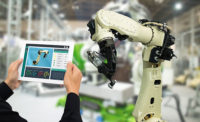The materials handling industry is undergoing a significant transformation, with a growing emphasis on automation and ergonomics. This shift is being driven by a variety of factors, including the ongoing labor shortage, the need for increased efficiency, and the desire to create safer and more ergonomic work environments.
In a recent podcast, Doug Backinger, Senior VP of Solutions Engineering and Innovation at Caster Concepts, discussed the key trends and drivers behind this shift. Backinger noted that the COVID-19 pandemic has accelerated the adoption of automation in the materials handling industry, as companies look for ways to mitigate the impact of the ongoing labor shortage.
“Companies are gonna find a way around that. And automation is one of those keys,” Backinger said. He explained that many companies are now looking to automate processes that were previously performed by human workers, such as the use of forklifts and cranes. This shift is not only helping to address the labor shortage, but is also allowing companies to create more flexible and efficient operations.
In addition to the push for automation, Backinger also highlighted the growing focus on ergonomics within the industry. He explained that many companies are now recognizing the importance of creating safe and healthy work environments for their employees, particularly in light of the ongoing labor shortage.
“Companies have realized the people I have are important. I need to keep them safe, I need to keep them happy, I need to keep them productive,” Backinger said. He noted that this focus on ergonomics is not only helping to reduce the risk of injuries, but is also allowing companies to attract and retain a more skilled and diverse workforce.
Looking ahead, Backinger believes that the materials handling industry will continue to see a shift towards automation and ergonomics. He cited the ongoing supply chain disruptions as a key driver of this trend, as companies look to create more resilient and efficient operations.
“I think especially for us and North American companies, they’ve seen, seen they might have the cheapest piece price, but if it’s coming from overseas and they can’t get it and they can’t get it for months, and they saw the disruptions that that caused to their businesses,” Backinger said. “They’ve now seen that, hey, we can look at a part that say costs a little more, but when we look at the total overall picture, the low, the actual total cost of ownership is lower.”
As companies continue to invest in automation and ergonomics, Backinger believes that the materials handling industry will see a number of long-term benefits. He cited the potential for increased productivity, efficiency, and safety as key areas of focus.
“Anything that a company can do to implement that has a solid return on investment, that increases the productivity of their operations, makes their operations more efficient, allows them to compete in the global marketplace,” Backinger said. “These are the types of projects that manufacturing companies are looking to implement and material handling has been.”








